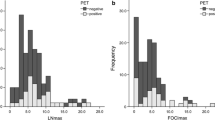Summary
The correlation of the preoperative staging by CT with the postoperative or postmortem staging was investigated in 74 patients with esophageal carcinoma. Criteria for the evaluation of local resectability were analyzed prospectively. According to TNM-classification, the pre- and postoperative staging showed identical results in T1 in 3/4, in T2 in 17/26 and in T3 in 42/44 patients. Thus, the preoperative staging turned out to be correct in 62/74 cases (83.7%). By conventional diagnostic methods identical results of pre- and postoperative staging were found in 28/74 patients (37.8%). The local resectability can be judged by the sagittal infiltration area and especially by the vertical extent of tumor infiltration of the aorta and/or trachea. Esophageal resection was not possible, if infiltration had been suspected in more than 4 tomograms (8 mm-CT-sections). Only palliative resection could be performed in cases with a 3 tomogram infiltration. A suspected infiltration up to 2 tomograms did not exclude a blind dissection of the esophagus without thoracotomy. The impression of the trachea with an irregular borderline of the lumen or tumor growth surrounding the trachea are additional infiltration signs in the CT. By the differentiated interpretation of local tumor growth the CT reached a central position planning surgical strategy.
Zusammenfassung
In einer prospektiven Studie wurde bei 74 Patienten mit Oesophaguscarcinom die Korrelation des prdoperativen Stagings mit CT zum postoperativen bzw. Obduktionsbefund geprüft. Es wurden Kriterien für die Beurteilung der lokalen Resektabilität des Tumors analysiert. Der Vergleich des prä- und postoperativen Stadiums nach TNM brachte mit CT im Stadium T1 bei 3/4 Patienten, im Stadium T2 bei 17/26 und im Stadium T3 bei 42/44 übereinstimmende Ergebnisse. Insgesamt lagen die richtigen Befunde nach zusätzlicher CT-Untersuchung bei 62/74 Patienten (83,7%). Übereinstimmende Ergebnisse nach konventioneller Diagnostik fanden sich bei 28/74 Patienten (37,8%). Für die Beurteilung der lokalen Resektabilität geben sagittale Infiltrationsfläche und besonders die axiale Infiltrationsstrecke zur Aorta und/oder Trachea entscheidende Hinweise. Bei einer im CT vermuteten Infiltration auf über vier aufeinander folgenden Tomogrammen war eine Oesophagusresektion nicht, ab drei Tomogrammen nur eine palliative Resektion möglich. Ein stumpfe Mobilisation des Oesophagus ohne Thoracotomie gelang bei einer im CT vermuteten Infiltration auf 1–2 Tomogrammen. Eine Impression der Trachea mit unregelmäßiger Begrenzung des Lumens oder eine Tumorummauerung ist neben der fehlenden Abgrenzung im CT als Infiltrationshinweis anzusehen. Durch die differenzierte Aussagefähigkeit über das lokale Tumorwachstum hat das CT in der Planung der chirurgischen Strategie eine zentrale Stellung erhalten.
Similar content being viewed by others
Literatur
Akiyama H (1980) Surgery for the carcinoma of the esophagus. Surgery 17:53
Akiyama H, Tsurumeru M, Kawamura T, Ono Y (1981) Principles of surgical treatment for the carcinoma of the esophagus. Ann Surg 194:38
Classen M, Philipp J (1981) Die Endoskopie des Carcinoms der Speiseröhre. Langenbecks Arch Chir 355:59
Crone-Münzebrock W, Gürtler KF, Brassow F, Thoma G (1983) Ergebnisse und Bedeutung der Computertomographie in der Diagnostik des Osophaguskarzinoms. Chir Praxis 31:37
Crummy AB (1968) Azygos venography; An aid in the evaluation of esophageal carcinoma. Ann Thorac Surg 6:522
Daffner RH, Halber MD, Postlewhait RW, Korobkin M, Thompson WM (1979) CT of the esophagus. II. Carcinoma. Am J Radiol 133:1051
Endo M, Kobayashi S, Suzuku H, Takamoto F, Nakayama K (1971) Diagnosis of early esophageal cancer. Endoscopy 3:61
Felix R (1981) Die Röntgendiagnostik des Oesophaguscarcinoms. Langenbecks Arch Chir 355:55
Gamstaetter G, Schild H, Rothmund M, Guenther R (1983) Computertomographie und prdoperatives Staging des Ösophaguskarzinoms. Z Gastroenterol 21:683
Grosser G, Wimmer B, Brobmann G, Ruf G (1982) Staging des Osophaguskarzinoms mit konventioneller Radiographie, Azygographie und Computertomographie. Radiologe 22:475
Halber MD, Daffner RH, Thompson WM (1979) CT of the esophagus. I. Normal appearence. Am J Radiol 133:1047
Husemann B (1982) Behandlung des Plattenepithelkarzinoms der Speiseröhre. Dtsch Med Wochenschr 107:1309
Kunath U (1980) Die stumpfe Dissektion der Speiseröhre. Chirurg 51:196
Lackner K, Küster O, Thurn P (1982) Computertomographie des Mediastinums und des Herzens. Internist 23:57
Mays ET, Gonzales RC (1964) Azygography — an aid in the evaluation of thoracic pathology. Arch Surg 88:233
Moertel CG (1978) Carcinoma of the esophagus: is there a role for surgery? The case against surgery. Am J Dig Dis 23:735
Mori S, Kasai M, Watanabe T, Shibuya I (1979) Preoperative assessment of resectability for carcinoma of the thoracic esophagus. Ann Surg 190:100
Moss AA, Schnyder P, Thoeni RF, Margulis AR (1981) Esophageal carcinoma: Pretherapy staging by computed tomography. Am J Radiol 136:1051
Pichlmaier H, Müller JM, Wintzer G (1978) Oesophagusersatz. Chirurg 49:65
Picus D, Balfe DM, Koehler R, Roper CI, Owen JW (1983) Computed tomography in the staging of esophageal carcinoma. Radiology 146:433
Reinig JW, Stanley JH, Schabel SI (1983) CT evaluation of thickened esophageal walls. Am J Radiol 140:931
Sans Segarra M, Cardus JC (1975) The value of azygography in carcinoma of the esophagus. Surg Gynecol Obstet 141:238
Stelzner F (1981) Die abdomino-cervicale Oesophagektomie. Langenbecks Arch Chir 355:63
UICC (1979) TNM-Klassifikation der malignen Tumoren und allgemeine Regeln zur Anwendung des TNM-Systems, 3. Aufl. Springer, Berlin Heidelberg New York
Yamada A (1979) Radiologic assessment of resectability and prognosis of esophageal carcinoma. Gastrointest Radiol 15,4 (3):213
Author information
Authors and Affiliations
Rights and permissions
About this article
Cite this article
Ruf, G., Brobmann, G.F., Grosser, G. et al. Wert der Computertomographie für die Beurteilung der lokalen Operabilität und die chirurgische Verfahrenswahl beim Oesophaguscarcinom. Langenbecks Arch Chiv 365, 157–168 (1985). https://doi.org/10.1007/BF01261143
Received:
Issue Date:
DOI: https://doi.org/10.1007/BF01261143




